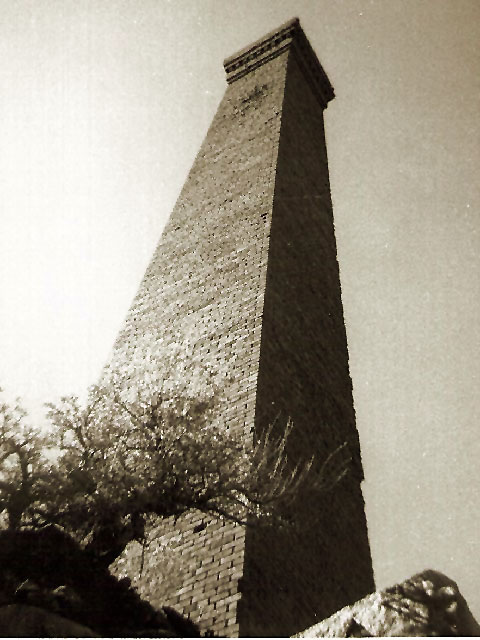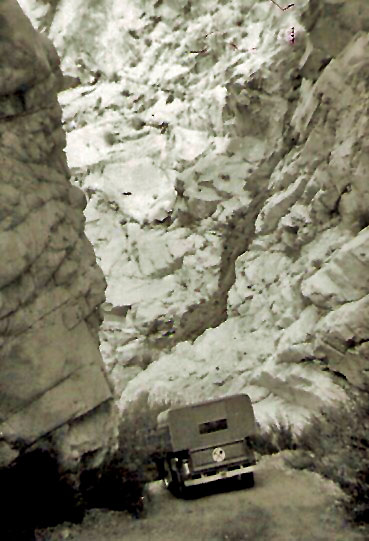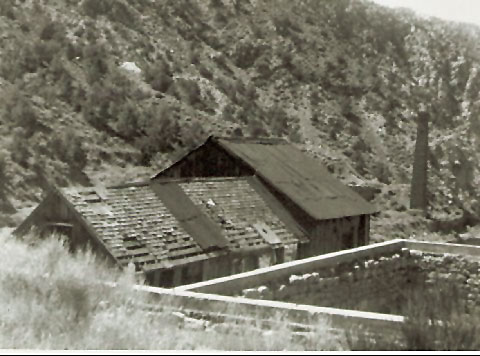|
NOTE: This story was
originally written for Desert Magazine, but never published.
In Likes’
words, the story is “only a window exposing a trip taken forty-three
years ago, through a canyon called Surprise, on a road that no
longer exists. For those accepting the challenge, the reward at the
end of the road was priceless. I find it interesting those magic
moments can no longer be duplicated. A historic passage that was
maintained for more than a hundred years is forever closed to the
traffic it was built to carry.”
When
the misguided emigrants of 1849 managed to escape from Death Valley
on route to the gold fields of California, they told anyone who
would listen of their desperate struggle to survive the hardships
encountered in that “hell hole”. Despite stories of pure silver in
the mountains west of this valley, the region was given such an evil
reputation it remained unexplored and cursed for years. Only after
the Comstock Lode silver strike in Nevada in 1858 were these
forgotten stories of treasures revisited. Exploring parties were
organized to backtrack the forty-niners and thoroughly prospect this
section of the Mojave Desert. Darwin French headed a party of
fifteen men to explore the area from Owens Valley east to Death
Valley in 1860. Dr. S. G. George lead another party into the same
area in 1861, but devoted more time searching the Panamint Mountains
that form the western wall of Death Valley.
 |
|
The Panamint
City smelter's smokestack as seen in 1963. It is one of
the few surviving structures today. |
Although these exploration parties were successful in mapping this
previously uncharted region of California and naming many of the
landmarks, the legendary bonanza of silver in the Panamints remained
just that¼a
legend. Several rich mineral deposits were discovered in other
sections of the desert, but the mysterious mountains west of “the
big sink” retained their secret. It was not until another decade
had passed that silver was found in the Panamint Mountains, but not
on, or even near, any of the routes taken by the forty-niners in
their frantic departure from Death Valley. The rich veins of silver
were discovered just below the crest line on the west side of the
mountain range, south of Telescope Peak.
The
year was 1873, and at the head of Surprise Canyon, at an elevation
of more than 6,000 feet, a legend was born.
It
is interesting to note the first man to scale Telescope Peak was W.
T. Henderson, a member of the previously mentioned Dr. George,
party. Henderson named the peak because “he could see for 200 miles
in all directions as clearly as though a telescope”. Yet the
elusive silver they searched for was discovered twenty years later
only two and a half miles from the lofty peak where Henderson stood.
Several books and numerous articles have been written about the
brief, but colorful history of Panamint City. They usually begin by
telling you how the town rose and fell in short span of three years,
and its’ population never exceed three thousand. They describe how
the mile long main street of fifty structures boosted mostly of
saloons, and give lengthy accounts of robberies and killings,
concluding, like the town, most of her citizens were as far from law
and order as you could get. They inform you Panamint City’s mines
never paid off as silver producers, that more money was put into the
ground than was ever taken out, and when the rich surface ores
disappeared, so did most of her people. They tell about sudden
cloud burst that sent a wall of water down the canyon, destroying
what was left of the dying community. They usually close by saying
the ruins of a smelter and a few stone buildings are all that is
left to see.
And
they are right¼.almost.
Only
one road went to Panamint City in 1874, and it still can be found a
mile north of the adobe ruins of Ballarat on a windswept alluvial
fan made of sedimentary fill left from a million winter storms. A
good dirt road takes you steadily up from the valley floor and soon
deposits you at the wide entrance to Surprise Canyon. Staying to
the south side and above the deep gorge whose perpendicular banks of
sand and rocks were carved by raging flash floods, the road moves
deeper into the canyon until it reaches one of the true oases in
this part of the desert. This is Cris Wicht’s camp. The cool water
in the large pond comes from a spring that runs year round. The
trees and abundant growth of greenery are in stark contrast to the
barren, inhospitable country around it. The abandoned wooden
structures are relics of a mining effort made here in the early
1900’s, and have no relationship to the Panamint City era.
 |
|
A pickup
makes its way through the confines of Surprise Canyon in
1963. The route today is impassible with ordinary
vehicles, and closed to vehicular access. |
The
road continues on, dipping down into the very bottom of the gorge,
and the towering canyon walls quickly close in as if objecting to
its’ presence there. The grade begins to rise sharply as the road
gets down to business of gaining altitude. You twist and climb for
several miles between solid rock walls scarcely sixteen feet apart.
Willows growing on the right complete with the road for room in the
narrow passageway. The confining sides of the canyon open slightly,
but the steep grade continues as the road relentlessly seeks its’
destination. Water seepage into the canyon makes traction on the
exposed bedrock difficult. The miles pass slowly, and the rising
temperature gauge of your vehicle gets more frequent glances.
Suddenly, the canyon widens and the grade eases, then rounding a
turn, the road finally delivers you into one of the most remote
locations in which a town was ever born. Your first reaction upon
arriving is relief, followed closely by admiration for the caliber
of men that drove stagecoaches and freight-wagons on daily trips
through that canyon.
The
road moves gently up through the middle of what seems to be a large,
long box canyon. Roofless stone cabins can be seen clinging to the
slopes on either side. Other ruins, half filled with rock and soil,
are scattered about the floor of the canyon. These picturesque
dwellings dot the landscape for half a mile, and provide an insight
into living conditions that existed for some of Panamint City’s less
fortunate citizens. Although small and primitive, they were well
constructed with mortar, indicating their occupants were planning to
stay.
Another area on the south side is terraced. Narrow rock pathways
that substituted for streets, carried men and beast in between
crowed living quarters of tents and hastily built wooden
structures. The large number of these terraced sites suggests the
speed at which the town grew. With limited space on the canyon
floor, the population had to seek less inviting locations to set up
housekeeping.
The
smelter and mill ruins at the eastern end of the canyon dominate the
scene, drawing you like a magnet. And well it should, for it was
literally the very heart of the town. When it stopped beating,
Panamint City died. Standing like a sentinel keeping watch over the
ruins, the remaining brick chimney rises eighty-five feet in the air
like an obelisk memorializing an amazing achievement. You wander
through the maze of carefully bricked passages and beautifully
formed arches, and marvel at the talent and knowledge that went into
the construction of this structure in such a wild and isolated
location.
 |
|
View of old
structures and smelter as seen in Panamint City in 1963. |
Camp
is made early in the evening on high ground. After dinner you enjoy
a hot cup of coffee and watch the last traces of daylight quickly
fade behind the distant Argus Mountains, barely visible through the
v-notch at the west end of the canyon. The purple and dark blue
silhouettes of the canyon wall surrounding you are curtains to the
outside world. You watch the layer of dark clouds closing in, and
make a mental note there might be rain before morning. You wonder
how many other uneasy nights were spent in the buildings that lined
Panamint City’s only street because they were also aware of their
vulnerable position on the canyon floor.
Dawn
finds you trying to shake the stiffness from your body while waiting
for that first welcome cup of coffee. The clouds are already
breaking up overhead, and by the time breakfast is finished, the
north walls of the deep canyon are bathed in bright sunlight. They
stand out boldly against the blue sky, challenging man to invade
their lofty heights just as they did nearly a hundred years ago.
And invade them man did, for all the mines were located on the
pine covered ridges high above Panamint City. Their location alone
is vivid testimony to the strength and endurance of the men who
worked them.
The
slanting rays of the sun chase the last chilling shadows from the
canyon, and you take time to leisurely roam the boulder strewn
ruins. It is not hard to imagine the incredible volume of churning
water, laced with crushing rocks and vegetation, that came roaring
down upon the town. The abruptly rising ridges that hem the entire
length of the canyon allowed no escape. Had not the mines closed
down, and the town been deserted, the incident would have been
disastrous, but as it was, nature was merely burying Panamint City's
ghost.
This
is the Panamint City I knew. A ruin that rewards its visitors with
a better understanding of the cold statistics recorded in the pages
of history. A place that gives you the deep thrill of standing in
the shadow of time knowing yesterday is just a touch away. A land
that confronts us with the same challenges it did our forefathers so
we might have a greater respect for their accomplishments¼¼.and
a tolerance for their weakness.
If
you are one of the restless few who enjoy following the dim trails
in search of yesterday¼¼welcome
to Panamint City.
Robert C. Likes, along with Glenn R. Day, is the author of FROM
THIS MOUNTAIN---Cerro Gordo. Known over the CB as “Ramrod”,
Likes traveled the dusty trails of yesterday more than four decades
ago as president of the Ghost Town club of Atomics International,
which later became Rockwell International. Some of his traveling
companions at the time were engineers and scientists who built the
rocket engines that propelled U.S. spacecraft to the moon.
Read More
Visit
Panamint Charlie's website for more Panamint City
history.
|
